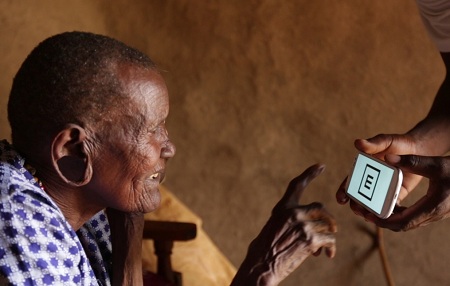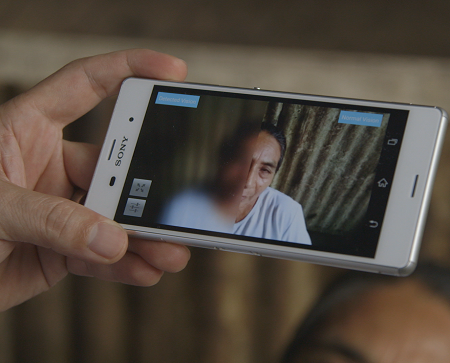Open Eyes, Open Source: Peek’s low-cost ophthalmoscope looks to gain traction, expertise through collaborations
Peek – a portable eye examination kit – arose as a solution to a real world problem: Trying to get precision medical equipment to remote locations in Kenya to study eye health in the region. None of the equipment being used was designed to be portable, none of it was cheap and none of it could be run without a reliable power supply.
With Peek (which I co-founded), we’ve managed to replace most of that equipment using just a phone and Peek Retina – our low-cost ophthalmoscope adapter. We’ve been fortunate in the generous grant support received, most notably from the Queen Elizabeth Diamond Jubilee Trust, that has enabled us to carry out the ongoing research into the effectiveness of our tools. We’re now in a position to start distributing what’s been developed, to maximise our impact on eyecare delivery in low-income settings.
The hardware
We’ve chosen to crowdfund the initial manufacturing run of Peek Retina, and you can check on the progress here. By crowdfunding, we are able to raise the capital we need to cover the industrial design and certification process without taking on an investor that would need to see a return on their investment. We gain early access to the market and can maintain our freedom to focus on maximising impact, rather than profit. It’s been a great tool for reaching out to our customers and helped generate further leads with distributors who may be longer-term partners in our rollout.
 Peek Retina is the core of our sustainability, and we’ll be operating a split pricing model. NGOs and health institutions operating in low-income countries will be able to purchase the adapter at a reduced price, while we sell at a higher price in high-resource settings. We’ll be offering efficiency savings and enhancements to care pathways in both settings, so we feel this is a fair way to operate that ensures everyone wins.
Peek Retina is the core of our sustainability, and we’ll be operating a split pricing model. NGOs and health institutions operating in low-income countries will be able to purchase the adapter at a reduced price, while we sell at a higher price in high-resource settings. We’ll be offering efficiency savings and enhancements to care pathways in both settings, so we feel this is a fair way to operate that ensures everyone wins.
(A patient tests his visual acuity, left.)
The software
We believe in an open source model for software. We need to get some regulatory boxes checked before we can release it publicly, as source code is considered a medical device just as much as our adapter or a compiled programme would be. As soon as that’s in place, we’ll be making all of our code available online for the wider community to contribute to and learn from.
This means that the diagnostic tests will always be freely available, but it doesn’t mean there isn’t a possible business model. We’ll make it as easy as possible for third parties to develop apps that integrate toward any backend data storage that may be needed, but data security and medical software development is a specialist area, and when it comes to Peek, we’ll be the experts. It’s not something we’re considering at the moment, but clearly there is an opportunity to charge for that expertise for large-scale integrations or survey tools.
Be open, be collaborative
Peek would not have gained the traction or the expertise we’ve been lucky enough to benefit from had we been quietly developing it behind locked doors.
 From the very beginning, Andrew Bastawrous (Peek’s ophthalmologist) was open about what we were trying to achieve, and when you’re open, people want to help. Iain Livingstone (Peek’s paediatric acuity lead) was already working on mobile eye tests, and rather than worrying about competing, we joined together to make something even better. Mario Giardini (Peek’s hardware lead) had experience with optics but not with eyes, and without him seeing a talk that Andrew gave on Peek, would never have thought to bring Peek Retina to life. We wouldn’t have gotten so much of the media attention that has opened up avenues like TED Talks and funding through Gifted Citizen and we wouldn’t have been able to move so far, so quickly if we were always worried about competitors learning what we were doing.
From the very beginning, Andrew Bastawrous (Peek’s ophthalmologist) was open about what we were trying to achieve, and when you’re open, people want to help. Iain Livingstone (Peek’s paediatric acuity lead) was already working on mobile eye tests, and rather than worrying about competing, we joined together to make something even better. Mario Giardini (Peek’s hardware lead) had experience with optics but not with eyes, and without him seeing a talk that Andrew gave on Peek, would never have thought to bring Peek Retina to life. We wouldn’t have gotten so much of the media attention that has opened up avenues like TED Talks and funding through Gifted Citizen and we wouldn’t have been able to move so far, so quickly if we were always worried about competitors learning what we were doing.
(A sight simulation, right.)
We don’t believe in software patents and want to be open source, so that makes our lives easier in this regard, but we wouldn’t have been able to take so many steps along the way if we weren’t so open about what we’ve been doing. We want to move forward the field of mobile eyecare, so that we can maximise our impact and help to prevent people from going blind.
Working with, not just for, the community
A crucial element of Peek’s success in terms of effectiveness and sustainability is the fact we have designed the system with local health care workers on the ground in Kenya. We worked hard to make sure the system was adapted to the real world environment and appropriate to the settings where Peek will be used.
At first we regularly found that things we designed didn’t work as well as we had hoped, and often for reasons we couldn’t have predicted. For example, using the light sensor to record brightness data, we discovered that a lot of our three-meter vision tests were being done in bright sunlight, which made it hard to see the screen. The reason was that it was often hard to find an indoor space that was three meters across. We redesigned the test to work at two meters and found all the tests could then be done inside.
We are testing Peek in many places now and plan more tests in the future – including Kenya, Mali, Botswana and India – to ensure we have the data to prove its efficacy and at every stage the technology will be improved and refined.
Stewart Jordan is co-founder and software developer at Peek, a British nonprofit.
- Categories
- Health Care, Social Enterprise, Technology
